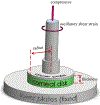Effect of corneal collagen crosslinking on viscoelastic shear properties of the cornea
- PMID: 35749931
- PMCID: PMC10826593
- DOI: 10.1016/j.jmbbm.2022.105300
Effect of corneal collagen crosslinking on viscoelastic shear properties of the cornea
Abstract
The cornea is responsible for most of the refractive power in the eye and acts as a protective layer for internal contents of the eye. The cornea requires mechanical strength for maintaining its precise shape and for withstanding external and internal forces. Corneal collagen crosslinking (CXL) is a treatment option to improve corneal mechanical properties. The primary objective of this study was to characterize CXL effects on viscoelastic shear properties of the porcine cornea as a function of compressive strain. For this purpose, corneal buttons were prepared and divided into three groups: control group (n = 5), pseudo-crosslinked group (n = 5), and crosslinked group (n = 5). A rheometer was used to perform dynamics torsional shear experiments on corneal disks at different levels of compressive strain (0%-40%). Specifically, strain sweep experiments and frequency sweep tests were done in order to determine the range of linear viscoelasticity and frequency dependent shear properties, respectively. It was found that the shear properties of all samples were dependent on the shear strain magnitude, loading frequency, and compressive strain. With increasing the applied shear strain, all samples showed a nonlinear viscoelastic response. Furthermore, the shear modulus of samples increased with increasing the frequency of the applied shear strain and/or increasing the compressive strain. Finally, the CXL treatment significantly increased the shear storage and loss moduli when the compressive strain was varied from 0% to 30% (p < 0.05); larger shear moduli were observed at compressive 40% strain but the difference was not significant (P = 0.12).
Keywords: Collagen crosslinking treatment; Cornea; Porcine eyes; Shear properties; Torsional shear experiments.
Copyright © 2022. Published by Elsevier Ltd.
Conflict of interest statement
Conflict of interest statement
None
Figures







References
-
- Kennedy RH, Bourne WM, and Dyer JA, A 48-Year Clinical and Epidemiologic Study of Keratoconus. American Journal of Ophthalmology, 1986. 101(3): p. 267–273. - PubMed
-
- Spoerl E, Huhle M, and Seiler T, Induction of cross-links in corneal tissue. Experimental eye research, 1998. 66(1): p. 97–103. - PubMed
-
- Wollensak G, Spoerl E, and Seiler T, Stress-strain measurements of human and porcine corneas after riboflavin–ultraviolet-A-induced cross-linking. Journal of Cataract & Refractive Surgery, 2003. 29(9): p. 1780–1785. - PubMed
-
- Wollensak G, Spoerl E, and Seiler T, Riboflavin/ultraviolet-a–induced collagen crosslinking for the treatment of keratoconus. American Journal of Ophthalmology, 2003. 135(5): p. 620–627. - PubMed
Publication types
MeSH terms
Substances
Grants and funding
LinkOut - more resources
Full Text Sources

